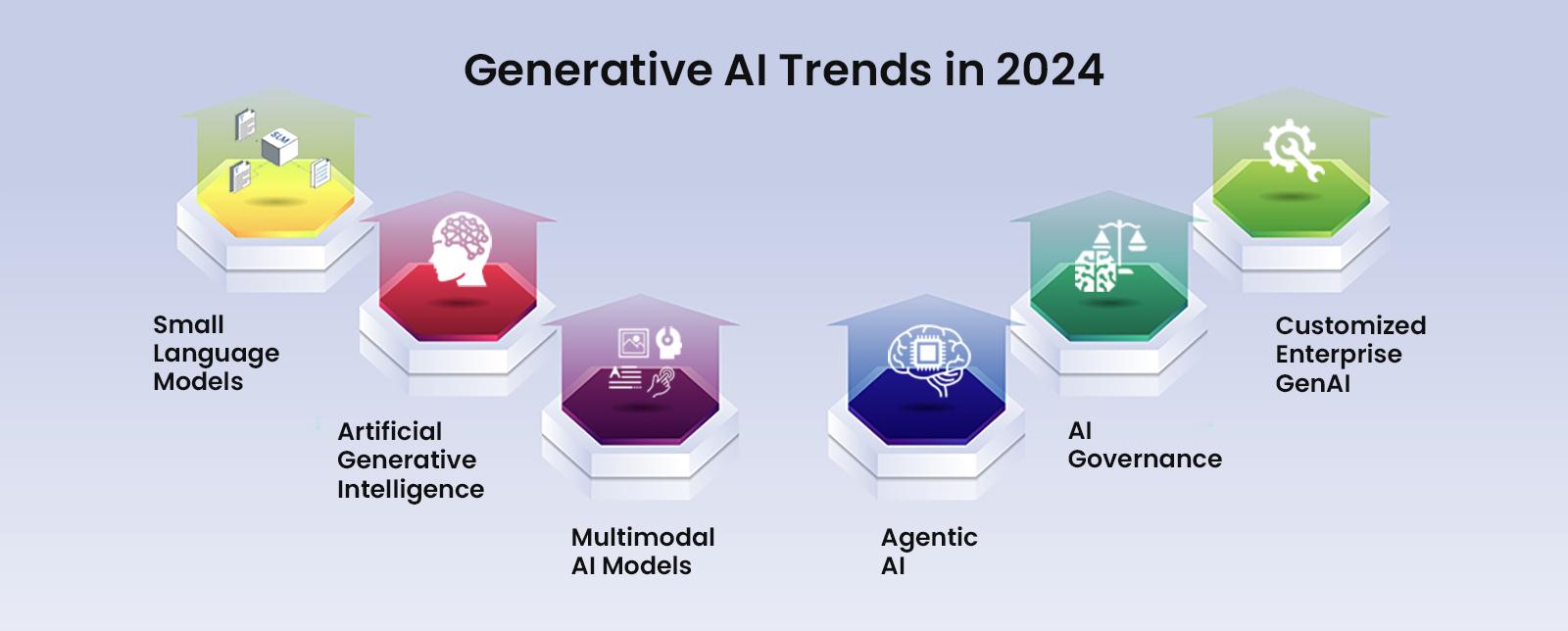The year 2023 was one of the most disruptive years in AI in a long time, with a large number of generative AI products moving into the mainstream. Continuing its transformative journey, generative AI is poised to transition from a buzz of excitement to real-world applications in 2024.
As tech companies continue to develop and fine-tune AI models, the generative AI landscape is rapidly evolving, giving rise to a wide range of trends that will boost the adoption of AI in industries and its presence in our daily lives. Let’s delve into top generative AI trends that will determine the real value of generative AI.
1. Small Language Models
After the runaway success of ChatGPT, we saw many companies releasing their large language models in 2023. However, now it’s time to brace yourself for the surge of small language models (SLMs). LLMs are trained on massive datasets scrapped from various public online sources and are capable of performing complex tasks that require human intelligence, from writing programming codes and logical reasoning to answering queries about nearly every imaginable topic.
However, handling such massive AI models with trillions of parameters requires a significant amount of computational resources and financial investment.
In contrast, small language models are trained on limited data for specific tasks and are more cost-effective. SLMs have fewer parameters and take up less storage space, making them suitable to run on less expensive hardware with lower computational power. When trained on high-quality training data extracted from trusted sources like textbooks, news websites, and magazines, the model can deliver outstanding performance. This will ramp up the adoption of these models.
Some of the popular SLMs so far are Meta’s Llama-2, Microsoft’s PHI-2, and Mistral 7B.
2. Artificial Generative Intelligence
The current level of artificial intelligence is not yet considered on par with human intelligence. AI companies aspire to develop a model that can match or surpass human comprehension and cognitive capabilities, a breakthrough that would be considered artificial general intelligence (AGI).
Instead of being limited to a specific area, AGI models can solve various problems at human cognitive levels without manual intervention. It can learn independently and solve unfamiliar problems without additional training. To put it in a nutshell, AGI is a concept of complete artificial intelligence that mirrors broad human cognitive abilities to understand and solve complex tasks.
In contrast, existing models depend on considerable training to understand and solve related problems within the same domain. For example, a pre-trained large language model (LLM) must be fed with financial datasets to make investment-related decisions.
AGI is the idea of a machine that can perform complex tasks across domains with human cognitive levels with little or no background knowledge of these tasks.
3. Multimodal AI Models (Chatbot)
Generative AI models transcend text creation by integrating multimodal versatilities. Multimodal AI will gain ground and bring about significant changes in the generative AI landscape in 2024.
Multimodal AI models are trained to learn and work with multiple forms of data such as text, photos and even sounds and video, with advanced algorithms so that they can generate different types of content i.e. text, images, sounds, and videos in response to prompts.
The combination of training datasets, including text, images, videos, and audio, trains systems to learn relationships between different types of media and enables them to identify one type of media and respond to another. For example, if you input an image, the model will generate text in response or vice versa.
This transition to AI models will make the technology more intuitive and dynamic. Gemini, GPT4-V, Gen-2, ImageBind, etc. are some popular models among users for their multimodal capabilities.
4. Agentic AI
While till now we have been able to chat with AI, until this year, we will see chatbots operating as agents. Tech companies are working to transform AI models into autonomous software programs meant for achieving specific objectives without direct human intervention.
These autonomous agents are designed using advanced algorithms and machine-learning techniques. The development of such agents essentially requires multimodal AI that integrates different technologies including machine learning, computer vision, natural language processing, etc.
These agents are designed to use data to learn patterns, set new targets, and work to achieve those objectives with no or little human intervention. They can predict, act, and interact effectively by analyzing different data types simultaneously and considering the current context.
For example, a financial AI agent could be trained to collect market data, analyze patterns, and adapt its investment strategies to the constantly changing market conditions in real-time.
5. AI Governance
The year 2024 will be a watershed in AI regulation, reshaping the development and ethical risks in generative AI strategies for a safe and secure AI application.
With the speed at which generative AI is entering into the mainstream, businesses are excited to leverage it to drive innovation and discover novel opportunities across various industries and applications. However, incorporating this cutting-edge technology is not without challenges. Rapid growth in AI has left regulators scrambling to keep pace with the technology.
Despite the potential to produce or predict desired outcomes, generative AI has raised concerns about hallucination, the spread of misinformation, deepfakes, etc. Moreover, the vulnerability of these models to prompt injections, poisoning, the disclosure of sensitive private information, copyright infringement, and the creation of biases and racist content has stressed the need for prompt regulatory responses globally.
Regulators are required to shape the future of AI governance, fostering innovation, and ensuring that guardrails are developed to protect the rights – and jobs – of a diverse workforce. As AI integrates into many industries, an alliance of industry leaders, governments, academic researchers, and civil society is necessary to create a successful regulatory framework for AI governance.
6. Customized Enterprise Generative AI Models
Massive large language and image models like ChatGPT vs Bard and Midjourney have taken the world by storm. However, for business use cases, small, customized enterprise generative AI models are on the rise. These models are designed by integrating proprietary data to meet niche markets and user requirements and ensure more accurate and relevant responses. The evolution of tailored enterprise AI applications indicates that businesses are moving towards more efficient and personalized AI-driven business solutions.
Enterprise generative AI can be customized for a variety of business requirements, including customer support, document review, and even supply chain management. These models are particularly useful for the finance, legal, and healthcare sectors, where terminology and practices are highly specialized. Organizations that integrate customized models into their operations have greater control over their data, leading to greater levels of privacy and security.
Given the privacy and security risks posed by generative AI models, stringent AI regulations could push businesses to transition to using proprietary models in the coming years.
Final Words
In 2024, the landscape of generative AI will continue to evolve rapidly with a slew of new trends, presenting consumers and enterprises with new challenges. Generative AI has enormous potential and its impact has just begun.
Author Bio
Rohan Agarwal is the CEO of Cogito, an AI training data company that is a global leader in its domain, offering human-in-the-loop workforce solutions comprising Computer Vision and Generative AI solutions. He has a biomedical engineering background with over a decade of experience in AI and related fields.
The post Top 6 Generative AI Trends to Look for in 2024 appeared first on Datafloq.



